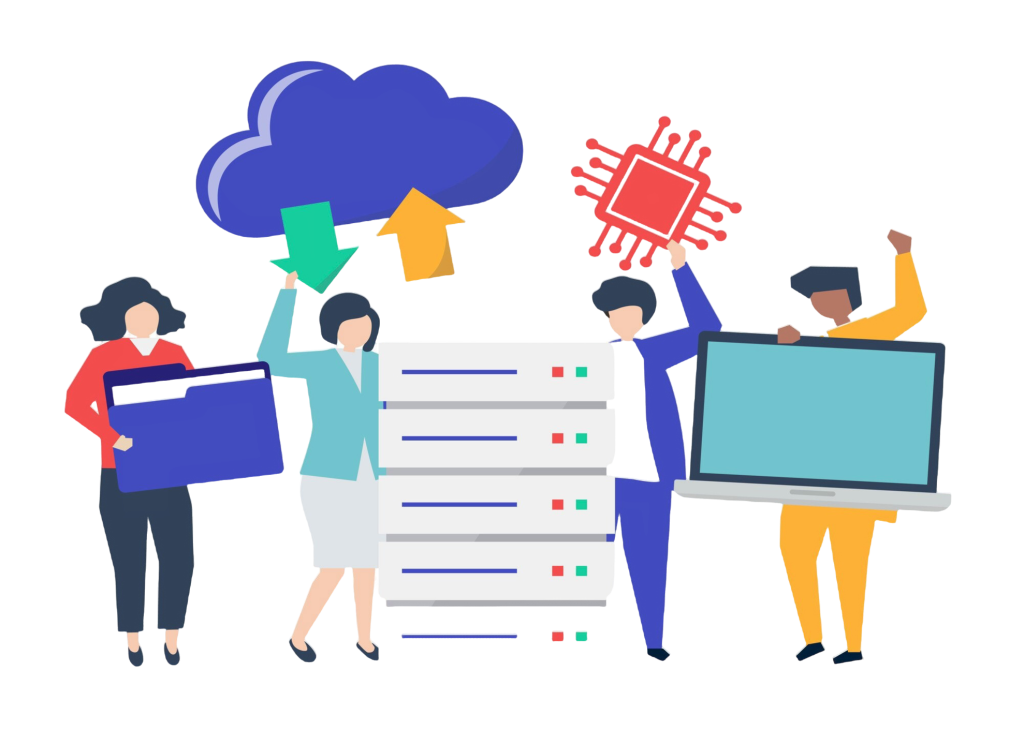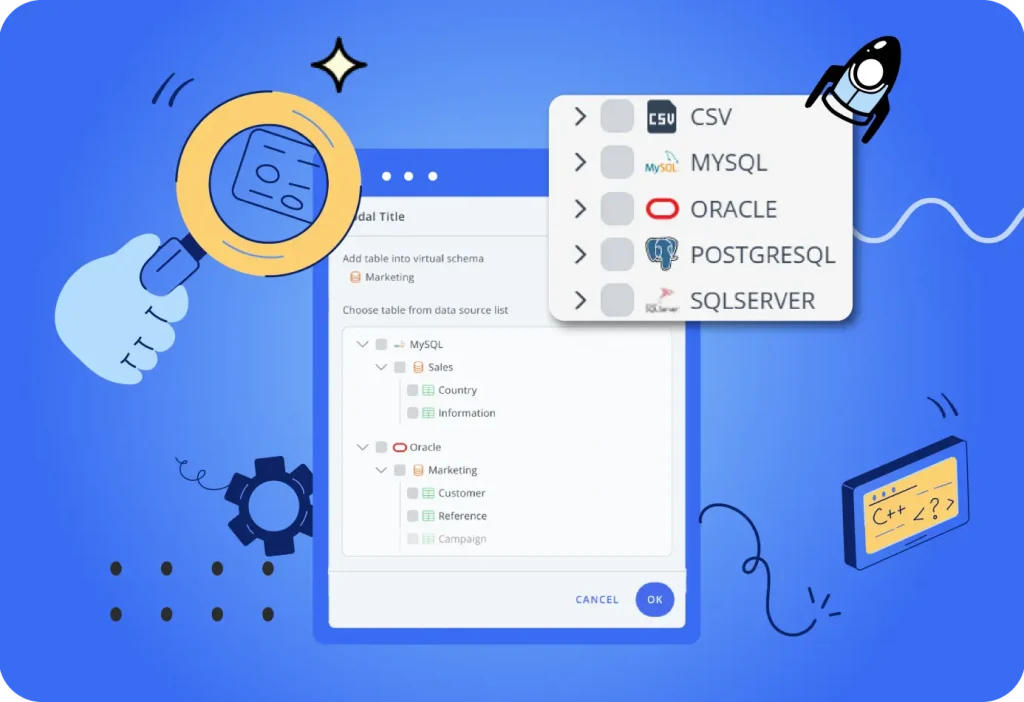Understanding Data Virtualization and Supported Sources

In the digital era, data has become a valuable asset for companies, but it is often scattered across various systems, formats, and platforms, making it difficult to manage. Virtualization offers a solution by enabling access and integration of data from multiple sources without the need for relocation or duplication. This technology creates an access layer that simplifies data management, allowing real-time analysis without altering the original sources. Use Case: Challenges Faced by Data Analysts in Data Integration A Data Analyst at a retail company is tasked with analyzing sales trends. The data needed comes from various sources: Before using virtualization, the team had to manually download and merge this data, which was time-consuming and prone to errors. With virtualization, the Data Analyst can access all this data in a unified view without relocating it, enabling faster and more efficient real-time analysis. Read Also : Supported data sources in Data Virtualization Supported Data Sources in Virtualization One of the key advantages of virtualization is its ability to connect with various data sources. Here are some of the data types that this technology can support: Diverse Data Sources Virtualization can connect various types of databases, both relational and non-relational, including: Various File Formats Besides databases, virtualization can also access and integrate data from different file formats, such as: Big Data Technologies In the world of big data, virtualization can connect with large-scale data processing technologies, such as: Benefits of Virtualization Faster Data Access: No need for physical data movement, which speeds up the analysis process. Cost Efficiency: Businesses can reduce the need to store data in separate systems, leading to significant savings. High Flexibility: This technology adapts well to various IT environments, whether on-premise or cloud-based. Enhanced Security: Since data remains in its original source, the risk of data breaches is minimized. Conclusion Virtualization is an effective solution for managing data from multiple sources without physically relocating it. With support for relational databases, NoSQL, file formats such as CSV and JSON, and big data technologies like Hadoop and Spark, virtualization offers high flexibility in data integration and analysis. This technology is an ideal choice for companies looking to improve data management efficiency in the digital era. If you want to optimize data management with virtualization technology, Dave is here to help! Try our service and experience seamless data access and integration on a single platform.
Optimizing Analytics Processes with Data Virtualization

Introduction In the ever-evolving business landscape, data management has become a crucial factor in supporting better decision-making. Data virtualization is one of the technologies that helps accelerate and simplify analytics processes by integrating data from multiple sources. This article will discuss how data virtualization facilitates data integration, its role in Business Intelligence (BI), and the advantages and challenges faced in its implementation. What Is Data Virtualization? Data virtualization is a technology that enables data integration from multiple sources without the need to physically consolidate the data into a single repository. This means that data stays in its original source, and systems can still access and process it for analytics and reporting. By utilizing data virtualization, businesses access data from various applications simultaneously, even when different databases store those data sets. This technology employs metadata layers and semantic layers to present real-time data, reducing reliance on traditional ETL (Extract, Transform, Load) processes, which are often time-consuming. With this architecture, data virtualization also supports machine learning (ML) and advanced analytics. Read Also : Data Virtualization in Business Intelligence and Analytics Case Studies and Implementation in Various Industries Data virtualization has been adopted across various industries such as finance, retail, and healthcare to enhance analytics and expedite decision-making. The Role of Data Virtualization in Business Intelligence (BI) and Analytics Data virtualization plays a crucial role in self-service BI, enabling business users to access and analyze data without waiting for IT teams or data administrators to process it. Additionally, data virtualization facilitates real-time decision-making, as the data accessed is always updated directly from its source. Furthermore, data virtualization enables integration with data lakes, allowing organizations to manage dispersed data sources without losing analytical flexibility. Challenges in Processing Data from Multiple Applications Most organizations rely on various applications for their operational needs, such as sales, production, product management, and inventory systems. However, problems arise when data from these applications must be consolidated for analytical reporting. Since each application maintains its own database, merging this data for reporting purposes becomes increasingly complex. Traditionally, this process requires downloading data from multiple databases and combining it in a centralized location, often within a data warehouse. However, this approach can be time-consuming and burdensome, especially when dealing with large datasets. Consequently, the time required to generate accurate and timely reports increases, impacting business efficiency. Advantages of Using Data Virtualization Unlike traditional approaches that require physical data consolidation, data virtualization allows data to remain in its original source. Applications such as sales, inventory, and product management maintain their respective databases. However, with data virtualization, data processing and report generation can be performed directly without the need to download and transfer data to a centralized database. Key advantages of data virtualization include: These benefits are particularly valuable as data volumes continue to grow, ensuring that businesses can process and analyze data more quickly without overloading their systems. Conclusion Data virtualization is an effective solution for overcoming data integration challenges and accelerating analytics processes. By leveraging this technology, businesses can consolidate and process data from multiple applications in real-time without requiring physical data movement. By gaining a deeper understanding of data virtualization, companies can optimize data-driven decision-making and enhance their competitive edge in the digital era. If you would like to learn more about how this technology can benefit your business, contact us for a free consultation.
Practical Steps to Implement Data Virtualization and Optimization Tips

After understanding the differences between data virtualization and ETL and their benefits in managing data efficiently, the next question is: how do you get started? This article discusses the practical steps to implement data virtualization in your organization and provides optimization tips to maximize results. 1. Analyze Data Requirements and Existing Architecture Before starting, analyze business needs and the existing IT architecture. Additionally, consider potential future requirements to ensure scalability. Review: With this mapping, you can identify critical areas that need early integration. 2. Choose the Right Data Virtualization Platform and Technology Select a platform that fits your organization’s needs. Consider: If using a cloud-based service, make sure you understand the cost structure to avoid unexpected expenses. Read Also : What is Data Virtualization A Practical Guide 3. Design the Virtualization Model Once you’ve chosen a platform, build the virtualization model with the following steps. Next, ensure your team understands the model’s structure and purpose. This stage allows data analysis without physically moving the data. 4. Conduct Testing and Validation Before full implementation, conduct a proof of concept (PoC): This testing helps identify potential issues early on. 5. Optimize Performance and Resource Usage 6. Integrate with Analytics and BI Tools Connect the data virtualization layer with your analytics and BI tools, such as Tableau or Power BI. Ensure compatibility with internal applications that need real-time access. 7. Evaluate and Continuously Improve Perform regular evaluations by monitoring: Conclusion Data virtualization offers a practical solution for cross-application data integration while optimizing resource use. By consistently applying these steps, your organization can maximize data potential without the need to move or duplicate physical data excessively. If you would like to learn more about how this technology can benefit your business, contact us for a free consultation.
How Data Virtualization Helps Businesses Manage Data Faster and More Cost-Effectively

In today’s digital era, data stands as one of the most critical assets for any business. Yet, the increasing number of applications and data sources poses growing challenges in terms of data management, processing, and storage. Data virtualization emerges as a solution, enabling companies to integrate data efficiently without building costly infrastructure. This article explores how data virtualization can reduce duplication, cut down on storage and network demands, and streamline the consolidation of data across multiple applications. The Challenges of Traditional Data Management Let us consider four internal systems in a company: Finance, Sales, Marketing, and HR. Each system has its own database, resulting in four distinct databases. If we do not utilize data virtualization and instead build a data warehouse or employ other traditional methods, the aggregated data can grow extremely large, necessitating a robust network. The greater the demand for network speed and bandwidth, the higher the associated costs. In addition, the need for storage also increases. Why? Because a significant amount of data duplication occurs. For instance, data from Finance is copied into a Centralized Database, and the same happens with data from Sales, and so on. Further, each system requires archiving and backups, causing data to multiply: stored across each system, the Centralized Database, archives, and backups. Consequently, the need for storage capacity rises, and so do the costs. How Data Virtualization Reduces Storage and Network Costs Moreover, the computational (CPU) load on the Centralized Database can become excessively high. Data from Finance, Sales, Marketing, and HR, which may have already been processed at their respective sources, has to be reprocessed by the Centralized Database. This means more compute power is required to manage and analyze large-scale data. Meanwhile, with data virtualization, we only consolidate at “Dave”—the data virtualization engine. This setup automatically reduces network requirements, lowers storage needs, and eases computational burdens. Costs associated with traditional extract, transform, load (ETL) processes can thus be significantly curtailed. Imagine, as well, that these systems (Finance, Sales, Marketing, and HR) operate in the cloud. Without “Dave”, you would need to download each dataset individually, which is highly time-consuming. Conversely, if all systems—including “Dave”—are also in the cloud, they can “talk” to each other much faster since they share the same infrastructure, eliminating the need for an expensive physical network. Platforms like Azure, AWS, Google Cloud Platform (GCP), BigQuery, or Snowflake offer interconnected cloud services. By placing “Dave” in the cloud, you can leverage these services and avoid the overhead of constructing your own costly network. It is important to note that large-scale infrastructure is not only expensive to acquire, but also demanding in terms of maintenance. You need specialized teams to keep systems running, ensure security (to prevent cyberattacks), and maintain uptime. All these responsibilities can cause total costs to skyrocket if you rely on traditional approaches. You would need a robust network, large storage capacity, and significant computational power. By contrast, data virtualization lets you utilize existing resources more efficiently, reducing both the time and expense required for data management. Why Businesses Should Adopt Data Virtualization By implementing data virtualization, companies can accelerate data processing, decrease infrastructure costs, and optimize current resources. If you would like to learn more about how this solution can be applied to your business, contact us for a free demo or schedule a no-cost consultation. Together, let’s achieve the kind of data efficiency that drives growth and innovation in your organization!
Why is Data Virtualization More Efficient Compared to ETL?

Imagine an organization that has four applications—let’s call them A, B, C, and D—each with its own database. If we use the ETL (Extract, Transform, and Load) method to combine data from these four databases, the steps are as follows: Extract Data from each database (A, B, C, and D) must be fully downloaded. This means a large volume of data is transferred over the network. Transform Once the data is extracted, the next step is transformation, because the format or representation of data in each database may differ. For instance, database A might store data in a “triangular” format, while B uses a “quadrilateral” format. Consequently, B’s data must be transformed into a “triangular” format so it can be combined with A’s data. Similarly, if C and D store data in “circular” or “pentagonal” formats, each must be transformed accordingly to ensure compatibility. Load The transformed data is then loaded into a centralized database—let’s call it Z. This database is where all the data from A, B, C, and D converges. The challenge is that Z must have a large capacity because it holds the combined data from all sources. In addition, Z requires high computational power (CPU) and storage, given the massive volume of data. This approach is commonly referred to as building a data warehouse or leveraging big data. Data Virtualization as a Solution Unlike ETL, data virtualization also aims to integrate data from A, B, C, and D to generate insights or reports, but in a more efficient way. The concept is to make it appear as if all data from these databases is stored in one virtual location—let’s call it X—even though, in reality, A, B, C, and D maintain their data locally. When a data request is made (for example, “Please show me the annual financial report”), the system then makes a specific request to each database: Processing at the Source When X requests data from A, for example, the initial processing happens in A. Only the necessary data is sent to X— not the entire dataset. The same process occurs for B, C, and D. Filtered Data The data sent to X is usually smaller, such as aggregated data, transformed data, or filtered data. This reduces network load because only relevant data is transferred. Consolidation at X Finally, X consolidates data from A, B, C, and D. The user accessing X can see the results as if all data was indeed stored in a single place, even though it remains physically distributed. See Also : Data Virtualization and ETL: Friends or Enemies? Advantages of Data Virtualization Reduced Network Load Because only processed or filtered data is transferred, the volume of data moving through the network is significantly lower than downloading the entire dataset. Efficient Storage With ETL, database Z must hold all combined data, requiring substantial storage capacity. In data virtualization, X only stores the integrated results (aggregated or filtered data), requiring less storage space. Distributed CPU Utilization Computational processes (initial transformations) occur on each database server (A, B, C, and D). X primarily consolidates the final data, so it does not require a powerful CPU to handle large-scale data processing. Greater Flexibility and Speed If the data format changes or a new data source is added, adjustments can be made more quickly because each source continues to operate on its own system. Integration takes place virtually, rather than by moving all data to a single location. Through these mechanisms, data virtualization proves to be a more efficient choice compared to ETL. It minimizes the network, storage, and computational burdens typically seen when data must be extracted, transformed, and loaded into a single, large database. Thus, data virtualization is a reliable solution for integrating data across multiple applications within an organization.
What is Zero ETL? Definition, ETL’s Challenges, ETL vs no-ETL Use Case

Every day, data has grown and evolved; every fundamental of any aspect has, and needs data. With data, a human + technology can drive decision-making, innovation, and efficiency across various fields. Data comes from many sources and data also exists all around us, but to collect and organize, data can be too much to handle. Before data can be useful, there is raw data that needs to be processed to make the data able to use, analyze, or make reports from it. Years ago, there was an ETL method that nowadays has been considered a traditional method, even though it used to be the most reliable method, but the process of the ETL method has become a challenge in today’s fast-paced, data-driven technology era. The ETL method works by gathering data from various sources (extract), organizing the data, transforming it into the same or consistent format (transform), including cleansing the data, validating and authenticating the data, etc., and finally loading it into specific locations (load), which could be into a data lake, a data warehouse, etc. Zero ETL on hands Simply put, zero ETL is an approach to integrating data without going through the traditional ETL process. The ETL method and non-ETL method have different approaches to manage data and integrate data. Few common problems or challenges when doing extract, transform and loads are: Data movement or data storage, over movement and storage places affecting many things such as time consuming or cost consuming Data integration, with ETL method, data integration have to through many steps Data latency, data might be still generated or updated in the source system only, then need to re-do for it available in the target system But with non-ETL are: Accessible with minimal coding required The obstacle to adapt with every query language is unnecessary, one query language can lead and finalize any analysis. Easy approach Simply pick the work space on desktop or on cloud, choose the package plan, install and integrate the database with software, input the details connection (host, port, database name, and authentication), make the virtual data and choose the data, and do the query for the analysis and report. Better cost than ETL options Cutting down many steps (ETL) into few steps (Dave) is surely affecting the cost effectiveness and efficiency. Dave is able to avoid any unnecessary process and cost, making it more profitable for any user. Real-time data processing/availability Able to process uncleaning, unstructured, unorganized, raw data. No need to extract data to become anything, less time consuming, and very importantly the processed data can give faster results and insight to make analysis or report. Simplified Architecture Processing data with data virtualization. Moving and transforming data are unnecessary steps. With data virtualization will make the process focus on direct, seamless, and real-time data integration. What does ETL method and Dave look like in real use cases? Let’s make a simple comparison of one case with two methods, the one with 5 steps to go and the other is simply 3 steps to get down to the analysis. Case Study Integrate data with Dave: simple, flexible, cost effective Motivation: Combining and analyzing data from various sources (CSV, PostgreSQL, MySQL, Oracle) for timely reporting. Prior data situation: Differences in database systems Varying data readiness times The need to use different programming languages Limited programming language skills Limited time Problem: A civil servant has few tasks and needs to be ready at the same time. Although the task has the same method to get done, it should be processed one by one. The civil servant is good at using PostgreSQL. The data he needs to process is available in a MySQL database, so the data needs to be dumped first into CSV format; this dumping itself took most of the time before the deadline. Another task is to make an analysis from the data on the Oracle database. Dave as solution: Integrate all of the source systems, direct connections, and easy virtualization of data (no ETL needed) by using Dave. Benefits: Cost saving Reduce ETL running time and lag time Finish analysis in a shorter period Comparison Without Dave With Dave Approach The analyst/civil servant needs to wait for the data to be ready before he can do analysis The analyst/civil servant just needs to integrate the database (no need to dump any data) and make virtual data Setup Time Weeks to set up ETL and data availability Hours to install Dave and link the databases with the credential Query Writing Effort The analyst should learn a new programming language in a short time Standard MySQL query language is enough; the analyst also does not need to learn a new query language After all, the real deal of zero-ETL is processing and getting the data without complicated data integration, delayed data availability, or high maintenance costs. This innovation with simplification will lead the way of how data is processed, once again, in this fast-paced data-driven era. Read more about Data Virtualization and Dave for better insight. Also, use Dave for better solutions.
Dave as the Best Data Virtualization Solution

In today’s world, where data is a critical factor, organizations face significant challenges managing data from various sources. Data, often stored in different systems, can make efficient access and integration difficult. This is where data virtualization comes into play, offering a unified view of data without the need for physical consolidation. What is Data Virtualization? Data virtualization is an advanced data management technology that allows users to access, manage, and manipulate data without knowing its physical location or format. Unlike traditional data integration methods that involve moving and consolidating data into a central repository, data virtualization enables real-time access and integration from multiple, heterogeneous sources. Key Benefits of Data Virtualization Real-Time Data AccessData virtualization provides real-time access to data from various sources, enabling timely and informed decision-making. Cost EfficiencyBy eliminating the need for data replication and consolidation, data virtualization reduces storage and processing costs. Enhanced Data GovernanceCentralized data access and control improve data governance and compliance with regulatory requirements. Agility and FlexibilityOrganizations can quickly adapt to changing business needs and data sources without significant changes to the underlying infrastructure. Better Data SecurityData virtualization enables secure data access and integration, ensuring that sensitive information is protected. How Does Data Virtualization Work? Data virtualization works by creating an abstraction layer between data consumers and the underlying data sources. This layer allows users to interact with data in a unified, logical manner, regardless of where the data physically resides. Here’s a step-by-step overview of how data virtualization functions: Data Source ConnectionConnect to various data sources, such as databases, data warehouses, cloud services, and big data platforms. Metadata ManagementCreate and manage metadata that describes the structure, relationships, and semantics of the data. Data IntegrationUse advanced data integration techniques to combine data from different sources into a unified view. Data AccessProvide real-time data access to users through various interfaces, such as SQL, APIs, and BI tools. Data Security and GovernanceImplement robust security measures and governance policies to ensure data integrity and compliance. Use Cases for Data Virtualization Business Intelligence and AnalyticsData virtualization enables seamless access to data from various sources, facilitating comprehensive and timely business intelligence and analytics. 360-Degree Customer ViewCreate a unified view of customer data from different systems, enhancing customer insights and personalized experiences. Data MigrationSimplify data migration processes by providing real-time access to data across old and new systems during transition periods. Big Data IntegrationIntegrate and analyze data from big data platforms with traditional data sources without the need for complex data movement. Challenges and Considerations of Data Virtualization While data virtualization offers numerous benefits, it also comes with its own set of challenges and considerations: PerformanceEnsuring optimal performance for real-time data access can be challenging, especially with large and complex data sets. Data QualityMaintaining data quality and consistency across different sources is crucial for accurate analysis and decision-making. ComplexityImplementing and managing a data virtualization solution requires a certain level of expertise and can be complex. CostAlthough it can reduce some costs, data virtualization solutions themselves can be expensive to implement and maintain. Why Choose Dave as Your Data Virtualization Solution? Dave is an OLAP data virtualization software that lets you access and analyze read-only data from various systems in a federated manner, allowing uniform access and query language across databases and file systems. Dave functions as a virtual database engine, enabling users to define virtual schemas and virtual tables from multiple physical database sources, and query those virtual tables within a single or multiple virtual schemas. This helps developers, database administrators, and data analysts work with various types of databases without switching between applications. Currently, Dave supports a variety of database systems, including MySQL, PostgreSQL, Oracle, Microsoft SQL Server, and CSV. More databases will be included in its development. Dave offers an exceptional data virtualization solution with features designed to tackle challenges and maximize the benefits of data virtualization. Here’s why Dave stands out: Seamless IntegrationDave provides seamless integration with various data sources, both old and new systems, as well as big data platforms. This makes comprehensive data access and management easier. User-Friendly InterfaceWith an intuitive user interface, Dave makes it easy for users to manage and access data without needing deep technical expertise. High PerformanceDave ensures high performance for real-time data access, allowing you to make quick and informed decisions with accurate and up-to-date data. Strong SecurityDave implements advanced security measures to protect your data from unauthorized access and ensure regulatory compliance. ScalabilityDave is designed for scalability, enabling you to handle growing data volumes without sacrificing performance. Cost-EffectiveAlthough Dave offers advanced features, our solution remains cost-effective by minimizing the need for additional infrastructure and expensive maintenance. Dave as the Best Data Virtualization Solution Data virtualization transforms how organizations access and integrate data, offering a flexible, efficient, and cost-effective solution to traditional data integration challenges. By providing a real-time unified view of data from diverse sources, data virtualization empowers businesses to make better decisions, enhance operational efficiency, and remain competitive in a data-driven landscape. Adopting data virtualization can be a game-changer for your organization, providing the agility and insights needed to thrive in today’s fast-paced, information-rich environment. By choosing Dave as your data virtualization solution, you gain access to cutting-edge technology that optimally supports your data needs. Ready to unlock the potential of data virtualization for your business? Try Dave today as your top data virtualization solution and achieve your data integration and management goals!
Dave The Hassle-Free Solution for Accessing Multiple Databases

In the ever-evolving and increasingly complex world of business, the need for efficient and effective data management has become more urgent. We need effective and efficient database management to make quick and accurate decisions while also reducing operational costs, thus boosting productivity. Imagine having a team that needs to master various types of databases and undergo intensive training, which consumes both time and money. Now, with Dave, all that hassle can be eliminated. There’s no need to train your team to master various types of databases. Just use Dave, and you can virtualize or access multiple databases easily. You no longer need to transfer large amounts of data that use different languages. Simply use Dave to access and analyze many databases. With Dave, you save on human resources and training costs, and make database system maintenance easier. Get to Know Dave Dave provides OLAP (Online Analytical Processing) data virtualization software that allows you to access and manage read-only data across various systems, whether they are available in the cloud or on-premises. With Dave, you connect to multiple data sources and technologies as if they were all in one place. Dave simplifies how you integrate data, create data queries, extract data for presentations, or share your data. The Use of Dave Dave Virtualize data from various data sources as if they were in the same place. Dave’s output can help users process data from various sources and report it in various visual forms, just by performing a simple query. Why Use Dave? Dave provides a software platform for Data Virtualization both in the cloud and on-premises. Data virtualization allows applications to retrieve and manipulate data without needing technical details about it, such as how the data is formatted at the source or where it is physically located. Data virtualization reduces the risk of data errors, eliminates the workload of moving data that may never be used, and avoids imposing a single data model on the data. This approach significantly benefits data integration and typically serves business intelligence, service-oriented architecture data services, cloud computing, enterprise search, and master data management. Dave Advantages Universal Data Integrator Dave enables data from various formats, locations, and technologies to be queried from a single place with a unified interface. This capability greatly benefits companies with multiple installed database systems. With more data in the cloud, Dave becomes the ideal solution. BI Accelerator Dave accelerates SQL queries by BI tools, creating fast times for BI creation and quick BI performance. Dave reduces time-to-market by eliminating traditional steps in creating data marts, such as ETL (Extract, Transform, Load). Dave directly accesses various data sources and integrates them into a single view. Empowering self-service analytics in a heterogeneous environment, Dave allows users to create dashboards instantly while data is scattered across many applications in your company or even in the cloud. Super SQL Dave supports SQL extensions for querying various data formats, allowing data engineers to use a single tool for almost every purpose in data preparation, cleaning, and modeling. Dave uses standard SQL to query multiple formats across different technologies, simplifying the data management process. ETL-less ETL-ing Dave simplifies the process of transforming and integrating data from various sources by providing a virtual database that houses all necessary data sources. This feature allows users to prepare data with simple queries as if all data were available in one database. Zero Staging Data Processing Dave eliminates the tedious and error-prone staging phase in data processing, significantly assisting data processing projects and reducing the likelihood of errors. Big Data Virtualization Dave queries data from various formats, locations, and technologies quickly. Dave performs all these tasks on large data sets swiftly, making it a high-performance engine for Big Data. Why Choose Dave? Several advantages make Dave stand out: Simplicity Dave allows users to manage, operate, and manipulate their data simply. Dave simplifies how you integrate data, create queries, extract data for presentations, or share your data. Flexible Pricing Dave offers flexible pricing, allowing companies of various sizes to benefit without worrying about high costs. Flexibility in Adopting Cloud and On-Premises Dave supports flexibility in adopting both cloud and on-premises/on IaaS, so you can choose the solution that best fits your business needs. Wide Support for Data Sources Dave supports various data sources, from SQL, NoSQL, to Big Data, ensuring compatibility is not an issue. High Performance Dave delivers high performance in querying and managing data, enabling you to work more efficiently and productively. Flexibility in Adding New Data Sources Dave allows you to easily add new data sources as your business needs evolve without making significant changes to the existing system. The Best Offer from Dave Dave primarily offers a Cloud service where users can visit the portal and subscribe to one of the available packages. With this offer, you can easily access Dave and start optimizing your data management without hassle. Use Dave Now Dave offers a practical and efficient solution for accessing and managing multiple databases without the hassle of training your team. With superior features such as simplicity, flexible pricing, support for various data sources, and high performance, Dave is the right choice for companies looking to optimize their data management. Access multiple databases easily and cost-effectively with Dave. Dave provides a hassle-free solution for businesses needing efficient data management. By integrating various databases into one platform, Dave allows businesses to save on training and human resource costs. It simplifies the process of querying and managing data, making it accessible for companies of all sizes. With its user-friendly interface and robust features, Dave stands out as a leading choice for data virtualization. Whether your data resides in the cloud or on-premises, Dave ensures you can access and manage it seamlessly. In a world where data drives decision-making, having a tool like Dave can make a significant difference. It not only improves efficiency but also enhances the overall productivity of your team. By
